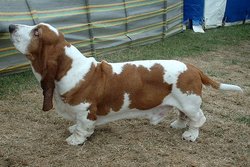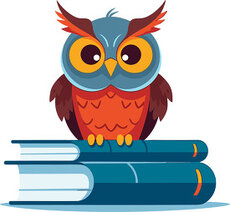Basset Hound
|
|
| Basset Hound | |||||||||||||||||||||
|---|---|---|---|---|---|---|---|---|---|---|---|---|---|---|---|---|---|---|---|---|---|
| Country of origin | |||||||||||||||||||||
| France | |||||||||||||||||||||
| Classification and breed standards | |||||||||||||||||||||
|
The Basset Hound is a chunky, short-legged breed of dog of the hound family. They are scent hounds, bred to hunt by scent. Their sense of smell for tracking is second only to that of the Bloodhound. The name Basset derives from the French word "bas" meaning "low" or "dwarf".
| Contents |
Appearance
These dogs are around 33 to 38 cm (13 to 15 inches) in height at the withers. They have smooth, short-haired coats and are generally tricolor (black, tan, and white); red and white; or lemon and white, though less commonly. They have long, low-set ears and powerful necks, with much loose skin around their heads that forms wrinkles. Their tails are long and tapering and stand upright with a curve. The breed is also known for its hanging skin structure, which causes the face to have a permanently sad look; this, for many people, adds to the breed's charm. The loose, elastic skin around the neck and trailing ears are thought to help catch the scent of what they are tracking.
Temperament
The Basset Hound is a calm and companionable breed, but they are often very stubborn. They are an especially loyal breed, are very friendly, and will gladly play with children. Bassets are amiable and generally love being around people.
When left on their own, Bassets tend to excessively eat and sleep rather than exercise. Care must be taken to prevent unhealthy weight gain. The mournful appearance of the Basset Hound can cause owners to be "sympathetic" and give them extra food; owners should resist this temptation lest their dogs become overweight.
Like other hounds, Basset Hounds are often very difficult to obedience train. Many Basset Hounds will obey commands when offered a food reward, but will "forget" the training when a reward is not present. Bassets are notoriously difficult to housebreak.
The breed has a strong hunting instinct and will give chase or follow a scent if given the opportunity. They should be trained in recall; failing that, they should be kept on a lead when out on walks.
Basset Hounds are a "large dog" on short legs. They were specifically bred to have dwarfism, specifically achondroplasia. Their short stature can be deceiving; Bassets are surprisingly long and can reach things on table tops that dogs of similar heights cannot.
History
Basset Hounds are an aristocratic breed of French lineage, a descendant of the St. Hubert's Hound, a dog similar to the present-day Bloodhound. Friars of St. Hubert's Abby in medieval France desired a shorter-legged dog, capable of following a scent under brush in thick forests, as hunting was a classic sport of the time. Both Bassets and St. Hubert's Hounds were bred to trail, not kill, their game. The first application of the word "Basset" to a breed of dog can be traced to an illustrated text on hunting written by Fouilloux in 1585.
Early French Bassets closely resembled the Basset Art鳩en Normand, which is still a breed today though it is not recognized outside of France. Because many short-legged dogs from this time were called basset and record-keeping from this time was sparse, it is difficult to speculate which of these breeds have bloodlines in common with today's Basset Hounds. It is commonly believed that Marquis de Lafayette brought Basset Hounds to the United States as a gift to George Washington.
In 1863 the Basset Hound reached international fame at the Paris Dog Show. At that time there were two common Bassets, those with a rough coat (Basset Griffon) and those with smooth (Basset Fran硩s). The dogs were further classified by the length of their legs. The two popular Basset breeders at this time were M. Lane and the Count Le Couteulx.
In 1866, Lord Galway imported a pair of Le Couteulx Bassets to England, but it was not until 1874 that Basset Hounds were widely introduced there by Sir Everett Millais. The Kennel Club accepted the breed in 1882 and the English Basset Hound Club was formed in 1884. The American Kennel Club first recognized Basset Hounds as a breed in 1885. In 1935, the Basset Hound Club of America was organized in the United States. The current American breed standard was adopted in 1964.
Health
In comparison to other breeds, the Basset Hound is an especially healthy breed, but there are some illnesses to which they may fall prey.
They are a deep-chested breed, and are therefore prone to bloat. Many bloodlines are genetically prone to glaucoma, luxating patella, and ectropion ("cherry eye"). Young Bassets occasionally develop paneosteitis. Older Bassets occasionally develop Von Willebrand disease. Long dogs on short legs can easily develop back pain, especially if excessive weight is already a concern. Hip dysplasia can be a problem in Bassets.
Care
Bassets tend to shed a lot, but do not require frequent brushing. Like the Bloodhound, they are a "wet mouthed" dog and tend to drool. As Basset Hounds often overeat, feedings should be regulated to prevent weight gain. Long ears are prone to infection if not regularly cleaned. Trailing bellies and massive paws will carry and track dirt to the despair of many owners.
Dog Pictures and Clipart
- Pictures of Dogs (http://classroomclipart.com/cgi-bin/kids/imageFolio.cgi?direct=Animals/Dogs)
- Dog Clipart (http://classroomclipart.com/cgi-bin/kids/imageFolio.cgi?direct=Clipart/Animals/Dog_Clipart)
Clipart and Animal Pictures
- Clipart (https://classroomclipart.com/image/category/clipart.htm)
- Animal Clipart (https://classroomclipart.com/image/category/animal-clipart.htm)
- Animal Animated Clipart (https://classroomclipart.com/clipart/Animations/Animals.htm)
- Pictures of Animals (https://classroomclipart.com/image/category/animal-photos.htm)
- Amphibian Clip Art, Pictures and Photogaphs (https://classroomclipart.com/image/category/amphibian-clipart.htm)
- Farm Animal Clip Art, Pictures and Photographs (https://classroomclipart.com/image/category/farm-animal-clipart.htm)
- Mammal Clip Art, Pictures and Photographs (https://classroomclipart.com/image/category/mammal-clipart.htm)
- Marine Animal Clip Art, Pictures and Photographs (https://classroomclipart.com/image/category/marine-life-clipart.htm)
- Reptile Clip Art, Pictures and Photographs (https://classroomclipart.com/image/category/reptile-clipart.htm)
- Spider Clip Art, Pictures and Photographs (https://classroomclipart.com/image/category/spider-clipart.htm)



